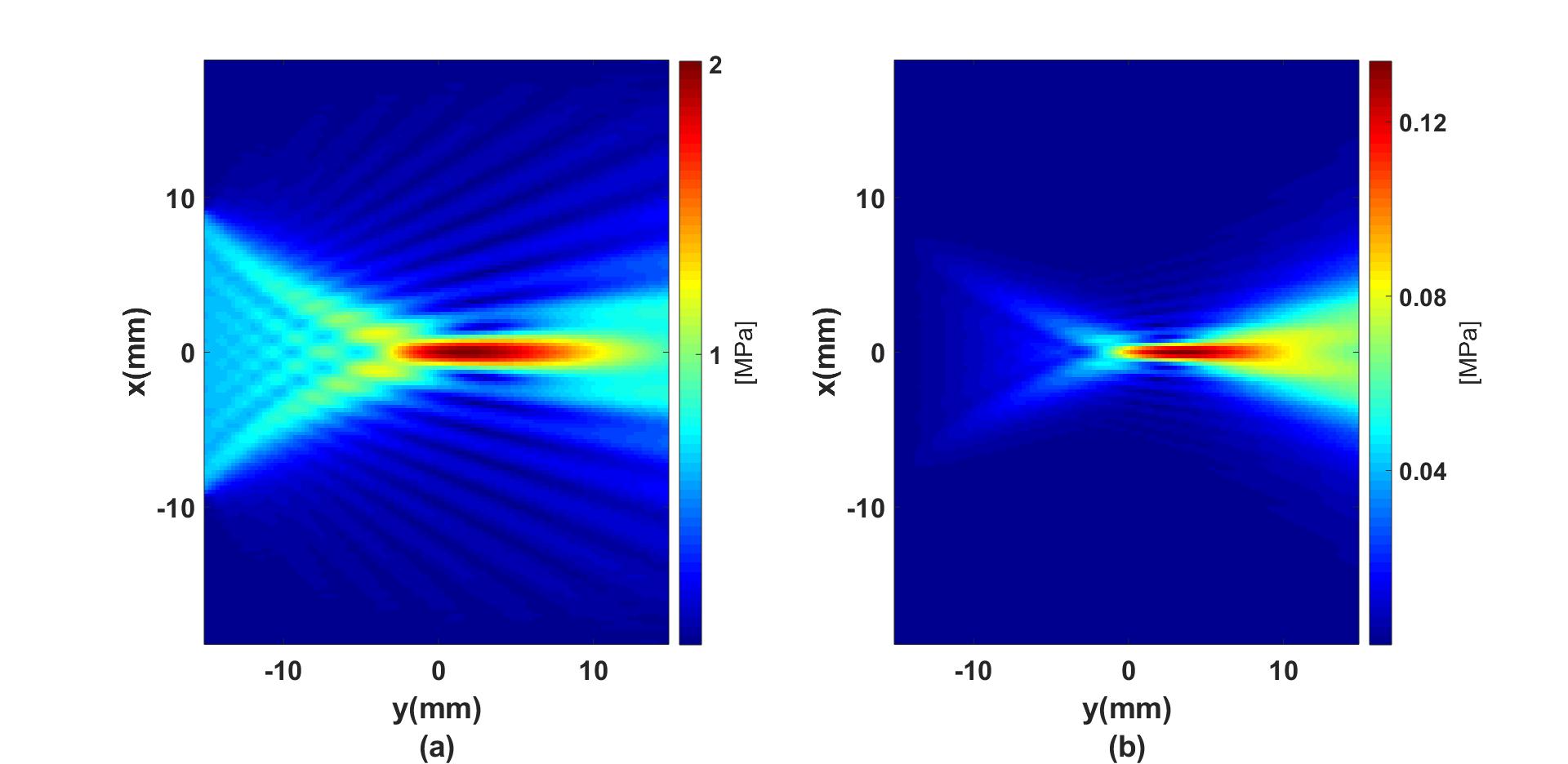Simulation of a 2D homogeneous medium using the frequency-specific mixed domain method
This example shows how to simulate the wave propagation in a 2D homogeneous medium with the frequency-specific mixed domain method. A focused beam is simulated.
Generating the grid structure in the computational domain
This simulation setup is based on the Simulation of a 2D homogeneous medium using the transient mixed domain method. The phase delay for each element in the transducer is similarly defined, albeit one is in the time-domain and the other one is in the frequency-domain. We first need to define the temporal and spatial computational domain in 2D forward simulations. In FSMDM, any arbitrary values can be set for the time step and temporal domain size , since they are not being used. Here, we set them to 0.
dx = 2.5000e-04; % step size in the x direction [m]
dy = 2.5000e-04; % step size in the y direction [m]
x_length = 0.0377; % computational domain size in the x direction [m]
y_length = 0.0300; % computational domain size in the y direction [m]
mgrid = set_grid(0, 0, dx, x_length, dy, y_length);
Excitation signal
Since the simulation is conducted in the frequency domain, a continuous sine wave is assumed as the excitation signal. Note that in this case, the pressure would be a complex number rather than a real number as in the TMDM.
omega_c = 2*pi*fc; % angular frequency [rad/s]
p0 = 0.6e6; % pressure magnitude at the source [Pa]
source_p = p0*exp(1i*omega_c*delay); % define the excitation
% apply truncation to construct the 1D linear array
excit_p(abs(mgrid.x)>TR_radius) = 0;
Defining the medium properties
For 2D simulations, the medium properties should be given as matrices with a size (mgrid.num_x, mgrid.num_y+1). For homogeneous medium, though, the medium properties can be described by a single scalar. medium.c0 is the reference speed of sound and generally, it is chosen as the minimum value of medium.c.
medium.c = 1500; % speed of sound [m/s]
medium.rho = 1000; % density [kg/m^3]
medium.beta = 3.6; % nonlinearity coefficient
medium.ca = 0; % attenuation coefficient [dB/(MHz^y cm)]
medium.cb = 2.0; % power law exponent
medium.NRL_gamma = 0.5; % constant for non-reflecting layer
medium.NRL_alpha = 0.1; % decay factor for non-relfecting layer
2D forward simulation
The fundamental pressure field is calculated with the 2D forward simulation function Forward2D_fund. The pressure field at the second-harmonic frequency under the quasi-linear approximation (weakly nonlinear wave propagation) is calculated with the function Forward2D_sec.
% forward propagation of the fundamental pressure
P_fundamental = Forward2D_fund(mgrid, medium, excit_p, omega_c, 0, 'NRL');
% forward propagation of the second-harmonic pressure
P_second = Forward2D_sec(mgrid, medium, P_fundamental, omega_c, 'NRL');

Other examples
·
Simulation of a 2D homogeneous medium using the transient mixed domain method
·
Simulation of a 2D heterogeneous medium using the transient mixed domain method
·
Simulation of a strongly 2D heterogeneous medium using the transient mixed domain method
·
Simulation of a 3D homogeneous medium using the transient mixed domain method
·
Selecting the proper temporal domain size for the TMDM
·
Shock wave simulations with TMDM
·
Simulation of a 2D homogeneous medium using the frequency-specific mixed domain method
·
Simulation of a 2D heterogeneous medium using the frequency-specific mixed domain method
·
Simulation of a 3D homogeneous medium using the frequency-specific mixed domain method
·
Simulation of a 3D heterogeneous medium using the frequency-specific mixed domain method
·
Reducing the spatial aliasing error using the non-reflecting layer
·
Comparing pressure release and rigid boundary conditions
·
Image reconstruction using backward projection
·
Reconstruction of the source pressure distribution with FSMDM in a 3D homogeneous medium
·
Integrating mSOUND with k-Wave for transducers of arbitrary shape
·
Integrating mSOUND with FOCUS for transducers of arbitrary shape
·
Integrating mSOUND with k-Wave for thermal simulations
